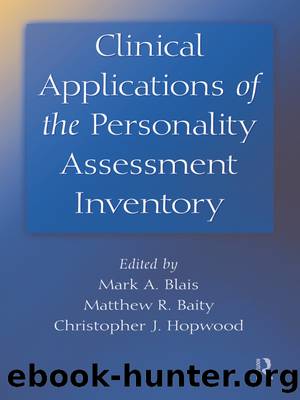Clinical Applications of the Personality Assessment Inventory by Blais Mark A.;Baity Matthew R.;Hopwood Christopher J.;

Author:Blais, Mark A.;Baity, Matthew R.;Hopwood, Christopher J.;
Language: eng
Format: epub
Publisher: Taylor & Francis Group
Published: 2011-09-02T00:00:00+00:00
Defensive Responding
Defensive response styles are common among individuals entering the criminal justice system. We encounter this issue especially with those undergoing preadjudicative assessments for possible diversion. These offenders are frequently concerned that the admission of severe problems will increase treatment length or result in additional charges, drug testing, or restricted housing during incarceration. They tend to admit to some problems that are already documented, but will categorically deny other problems associated with criminal or violent behavior. This pattern of partial honesty can complicate the assessment process.
The PAI can be used to detect defensiveness. PAI indicators of defensiveness, such as Positive Impression Management (PIM), the Defensiveness Index (DEF), and the Cashel Discriminant Function index (CDF), are valid indicators of defensive responding (Morey, 2007; Sellbom & Bagby, 2008). For example, PIM correlates with the Minnesota Multiphasic Personality Inventory-2 (Butcher, Dahlstrom, Graham, Tellegen, & Kaemer, 1989) K and L validity scales and moderates the relationship between Antisocial Features (ANT) scores and disciplinary infractions in offenders (Carr, Moretti, & Cue, 2005; Edens & Ruiz, 2006). Although these results are encouraging, PIM can have significant error rates, which may increase when respondents are coached on the presence and nature of the validity scales (Baer & Wetter, 1997; Fals-Stewart, 1996). The additional defensiveness indexes, DEF and CDF, can be used to supplement the interpretation of PIM scores. CDF scores are not associated with PIM and they can provide an indication, when elevated, that the respondent might be attempting to âfake good.â Although DEF is correlated with PIM (r = .56), primarily because PIM scores contribute to this index, these indicators have some different relationships with the clinical scales (Morey, 2006); the magnitude of the relationships between DEF and some externalizing scales (e.g., ANT, ALC, and Aggression [AGG]) is much lower than what is seen with PIM.
Collateral information can further clarify the issue of defensiveness in many cases. Information from criminal records, arrest reports, or other sources, all of which are readily available in most criminal justice contexts, can provide data that can be compared with PAI results to identify discrepancies. For example, individuals arrested for drug possession or driving under the influence often have a substance use disorder; suppressions on ALC and DRG in individuals with this type of criminal history should raise suspicions of defensiveness. Similar comparisons can be made for individuals with extensive histories of violent behavior because these individuals are likely to have elevated scores on the ANT, AGG, and the Violence Potential Index (VPI). Evaluators can also review item responses in relation to documented clinical history. Edens and Ruiz (2005) discussed the use of this strategy in the development of the Inconsistency-Corrections Index (ICI). The ICI contains two items that ask about historical events almost always experienced by individuals within correctional settings (e.g., trouble with the law; past illegal behavior). These events are usually well documented in most cases. Offenders who deny past illegal behavior and trouble with the law are possibly distorting their responses. The PAI-sensitive items are another source of information that may be useful.
Download
This site does not store any files on its server. We only index and link to content provided by other sites. Please contact the content providers to delete copyright contents if any and email us, we'll remove relevant links or contents immediately.
The Art of Thinking Clearly by Rolf Dobelli(9915)
The 5 Love Languages: The Secret to Love That Lasts by Gary Chapman(9281)
Mindhunter: Inside the FBI's Elite Serial Crime Unit by John E. Douglas & Mark Olshaker(8702)
Becoming Supernatural by Dr. Joe Dispenza(7836)
The Road Less Traveled by M. Scott Peck(7279)
Nudge - Improving Decisions about Health, Wealth, and Happiness by Thaler Sunstein(7244)
Mastermind: How to Think Like Sherlock Holmes by Maria Konnikova(6937)
Enlightenment Now: The Case for Reason, Science, Humanism, and Progress by Steven Pinker(6875)
Win Bigly by Scott Adams(6828)
The Way of Zen by Alan W. Watts(6289)
Factfulness: Ten Reasons We're Wrong About the World – and Why Things Are Better Than You Think by Hans Rosling(4487)
The State of Affairs by Esther Perel(4485)
Gerald's Game by Stephen King(4376)
Man's Search for Meaning by Viktor Frankl(4275)
The Confidence Code by Katty Kay(4040)
Thinking in Bets by Annie Duke(3997)
The Worm at the Core by Sheldon Solomon(3325)
Hidden Persuasion: 33 psychological influence techniques in advertising by Marc Andrews & Matthijs van Leeuwen & Rick van Baaren(3292)
Enlightenment Now by Steven Pinker(3274)
